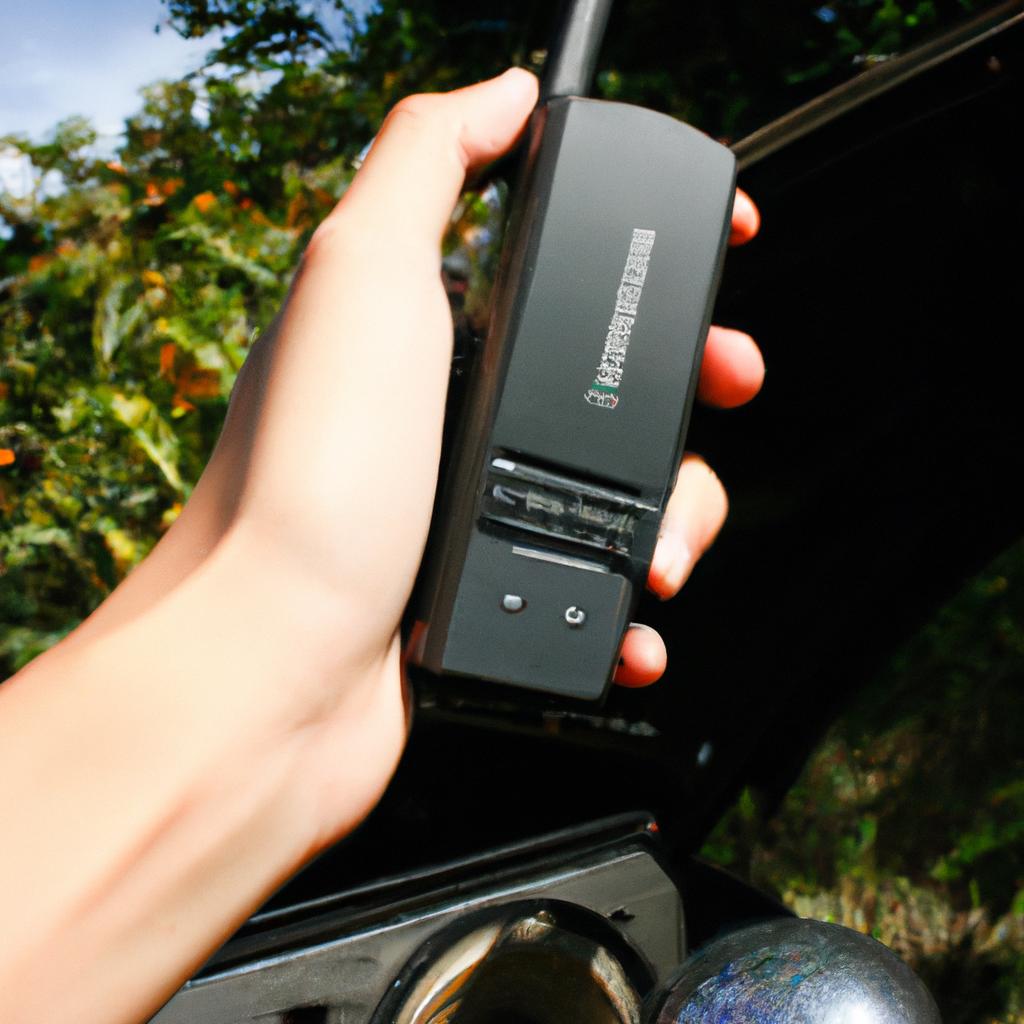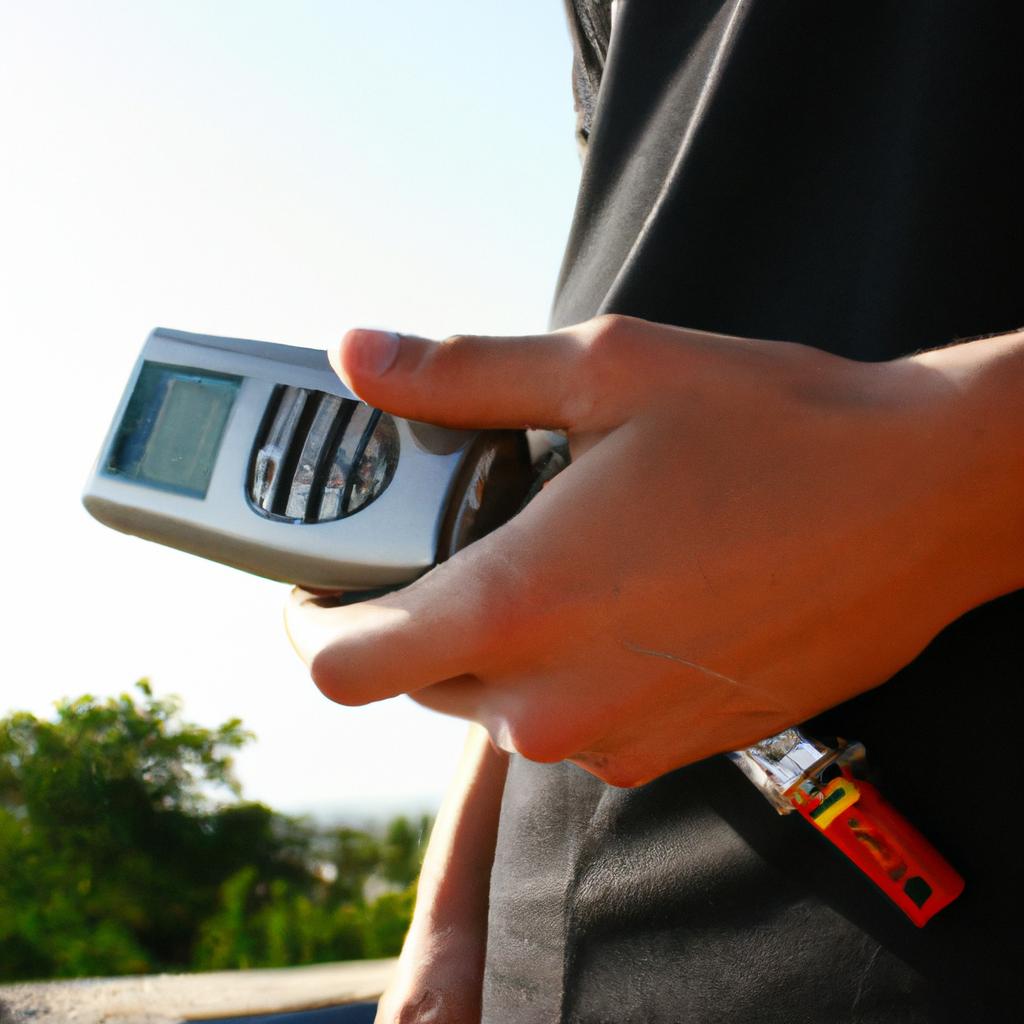Antenna performance is a critical factor in satellite radio systems, as it directly impacts the quality and reliability of signal reception. The ability of antennas to effectively capture and transmit signals is crucial for ensuring seamless communication between satellites and ground stations. To illustrate the importance of antenna performance, consider a hypothetical scenario where an individual residing in a remote area relies on satellite radio for their daily news updates and entertainment needs. In this case, any degradation in antenna performance could result in poor signal strength or even complete loss of connectivity, significantly impacting the user’s ability to access desired content.
In order to comprehend the intricacies of antenna performance in satellite radio systems, it becomes essential to examine various factors that influence its effectiveness. These factors include antenna design parameters such as gain, directivity, polarization efficiency, and impedance matching. Additionally, environmental conditions like atmospheric attenuation and interference from other sources also play a significant role in determining overall antenna performance. Understanding these elements helps engineers optimize system design by selecting suitable antennas that can handle different frequencies and adapt to varying environmental conditions.
This article aims to provide an informative overview of antenna performance in satellite radio systems by delving into concepts such as radiation pattern analysis, link budget calculations, and modulation techniques used for efficient data transmission. By exploring these aspects, By exploring these aspects, we can gain a deeper understanding of how antenna performance impacts the overall quality and reliability of satellite radio systems. We can also learn about the importance of proper installation and alignment to ensure optimal signal reception and minimize interference. Additionally, this knowledge can aid in troubleshooting antenna-related issues and implementing effective solutions to improve system performance.
Overall, understanding antenna performance in satellite radio systems is crucial for engineers, technicians, and users alike. It allows us to appreciate the complexity involved in ensuring seamless communication between satellites and ground stations, ultimately enhancing the user experience and satisfaction with satellite radio services.
Antenna Basics: Understanding the Functionality
Imagine you are driving through a remote area, enjoying your favorite satellite radio station. Suddenly, the audio begins to crackle and fade away. Frustrating, isn’t it? This scenario highlights the importance of understanding antenna basics in satellite radio systems. In this section, we will delve into the functionality of antennas and their significance in ensuring reliable signal reception.
To begin with, an antenna is a crucial component that receives and transmits electromagnetic waves. It acts as a bridge between the space-based satellites and your radio receiver on Earth. The process starts when the satellite emits signals containing information such as music or talk show content. These signals travel through space at tremendous speeds until they reach our planet’s atmosphere. At this point, antennas play a vital role by capturing these signals from outer space and converting them into electrical currents that can be processed by receivers.
It is essential to understand some key points regarding antenna performance in satellite radio:
- Proper alignment: Aligning the antenna correctly ensures optimal signal strength and minimizes interference.
- Antenna gain: A measure of how well an antenna converts electrical power into useful RF energy for transmission or reception.
- Polarization: The orientation of the electric field produced by an antenna determines its polarization characteristics.
- Frequency response: Different types of antennas exhibit varying levels of efficiency across different frequency bands.
| Factors affecting antenna performance | Description | Example |
|---|---|---|
| Atmospheric conditions | Weather conditions such as rain or snow can affect signal quality due to absorption | Heavy rainfall may cause temporary signal loss |
| Physical obstructions | Buildings, trees, or terrain features can obstruct line-of-sight communication paths | Tall buildings in urban areas could hinder signal reception |
| Interference | Other electronic devices operating on similar frequencies might introduce noise | Nearby Wi-Fi networks interfering with satellite radio reception |
| Antenna size and design | The physical characteristics of the antenna can influence its performance | Smaller, compact antennas may have limited signal range |
In summary, understanding antenna basics is crucial for ensuring reliable satellite radio reception. By aligning the antenna properly, considering factors such as gain, polarization, and frequency response, users can optimize their listening experience. Moreover, environmental conditions, obstructions, interference, and antenna size or design also significantly impact overall performance.
Transitioning into the subsequent section about “Factors Affecting Antenna Performance in Satellite Radio,” it becomes clear that exploring these factors will provide a deeper insight into overcoming potential challenges and maximizing signal quality.
Factors Affecting Antenna Performance in Satellite Radio
Now, let’s delve deeper into the factors that affect antenna performance in satellite radio. To illustrate this, consider a hypothetical scenario where a satellite radio user experiences poor signal reception and wants to understand why.
-
Environmental Factors:
The first factor influencing antenna performance is the environment surrounding the receiver. Interference from tall buildings, mountains, or dense vegetation can obstruct the path of radio waves between the satellite and the antenna. Additionally, weather conditions such as heavy rain or snowfall can attenuate signals, leading to reduced reception quality. -
Antenna Placement:
Another crucial aspect is the placement of the antenna itself. The ideal location for an antenna would be free from obstructions and positioned in a way that maximizes line-of-sight with satellites. In our example case study, improper mounting on a metal surface (which can interfere with signal propagation) or placing it too close to other electronic devices could contribute to degraded performance. -
Antenna Characteristics:
Different antennas have varying characteristics that impact their ability to capture signals effectively. For instance, some antennas are designed specifically for outdoor use and offer higher gain compared to indoor ones. Gain refers to how well an antenna focuses received energy towards a specific direction — higher gain results in stronger signals but at narrower angles.
To further emphasize these points:
- Imagine sitting by your window during a rainy day while trying to listen to your favorite music station on satellite radio.
- Picture this table showcasing different environmental factors affecting signal reception:
| Factor | Impact |
|---|---|
| Obstructions | Signal blockage |
| Weather | Signal attenuation |
| Physical barriers | Signal reflection/scattering |
As we conclude this section discussing factors affecting antenna performance in satellite radio systems, it becomes evident that understanding these influences is vital for optimizing reception quality. In the subsequent section about “Types of Antennas Used in Satellite Radio,” we will explore the various antenna designs employed to overcome these challenges.
Types of Antennas Used in Satellite Radio
Having explored the factors that influence antenna performance in satellite radio, we now turn our attention to understanding the various types of antennas commonly employed in this domain. By examining these different antenna designs and their characteristics, we can gain valuable insights into how they contribute to optimizing signal reception and transmission.
Antenna Types and Characteristics:
To better comprehend the range of options available for satellite radio antennas, let’s consider an example scenario involving a residential user named Alex. Alex resides in an urban area with tall buildings surrounding his apartment complex. Due to these obstructions, his satellite radio reception has been less than satisfactory. In search of a solution, he begins exploring alternative antenna options suited for such environments.
In evaluating different antennas suitable for urban settings like Alex’s, it is crucial to understand their key features and advantages. Here are some notable considerations when selecting a satellite radio antenna:
- Size and Form Factor: Compact antennas designed specifically for urban areas offer improved flexibility during installation.
- Gain: High-gain antennas amplify weak signals effectively, making them ideal for locations with interference or obstacles.
- Beamwidth: Narrow beamwidth allows concentrated signal reception within specific angles, enhancing performance amidst urban clutter.
- Mounting Options: Versatile mounting choices enable users to install antennas on rooftops or balconies for optimal positioning.
Table 1 provides a comparative overview of three popular satellite radio antennas based on the aforementioned criteria:
| Size | Gain | Beamwidth | |
|---|---|---|---|
| Model A | Compact | Moderate | Wide |
| Model B | Large | High | Narrow |
| Model C | Medium | Low | Moderate |
As we can see from the table, Model A offers a compact size suitable for urban settings while providing moderate gain and wide beamwidth. On the other hand, Model B boasts high gain and narrow beamwidth, making it an excellent choice in densely populated areas with potential signal interference. Finally, Model C strikes a balance between these extremes.
Antenna Placement: Impact on Signal Strength:
Considering that antenna placement significantly affects satellite radio performance, our subsequent section will delve into exploring how different positioning strategies influence signal strength and reception quality. By understanding the vital role of optimal antenna placement, users like Alex can make informed decisions to enhance their listening experience without compromising signal reliability.
With antenna design characteristics now elucidated, let us shift our focus towards examining the impact of antenna placement on satellite radio signal strength. This exploration will shed light on the importance of strategic antenna positioning for achieving optimal reception capabilities.
Antenna Placement: Impact on Signal Strength
In the previous section, we explored the different types of antennas used in satellite radio. Now, let us delve into another crucial aspect that significantly affects antenna performance in satellite radio systems – antenna placement. To illustrate this further, let’s consider a hypothetical scenario where two identical satellite radios are installed in two different locations within a city.
Firstly, imagine one radio is placed near tall buildings in an urban area, while the other is situated in a more open and rural environment. The signal strength experienced by these radios will vary due to their distinct placements. This example highlights how antenna placement can influence signal reception and overall system performance.
The impact of antenna placement on signal strength can be attributed to several factors:
- Obstructions: When an antenna is located close to obstructions such as buildings or trees, it may experience signal blockage or interference. These obstacles can weaken the received signals or cause reflections that result in multipath fading.
- Ground Reflections: Antennas positioned near reflective surfaces like water bodies or large metal structures can encounter reflected signals arriving at varying angles. This phenomenon interferes with the direct line-of-sight path between the satellite and the receiver.
- Elevation Angle: The elevation angle between the antenna and satellites plays a critical role in determining signal quality. A low elevation angle increases atmospheric attenuation and reduces signal power received by the antenna.
- Interference Sources: Nearby electronic devices or transmitters operating on similar frequencies as satellite radio signals can introduce unwanted electromagnetic noise, affecting overall reception quality.
| Factors | Urban Area | Rural Area |
|---|---|---|
| Obstructions | High density; taller buildings | Sparse; few obstructions |
| Ground Reflections | Limited reflective surfaces | Potential reflections from water bodies or large metal structures |
| Elevation Angle | Potentially low due to tall buildings | Generally higher |
| Interference Sources | Numerous sources present | Fewer potential interference sources |
As we can see, antenna placement in satellite radio systems is a critical factor that significantly affects signal strength and overall performance. By considering the various factors mentioned above, engineers can strategically position antennas for optimal reception.
Moving forward, let us now explore the key metrics used in measuring antenna performance in satellite radio systems. Understanding these metrics will provide deeper insight into evaluating and comparing different antennas’ effectiveness and suitability for specific applications.
Measuring Antenna Performance: Key Metrics
In the previous section, we explored how antenna placement plays a crucial role in determining signal strength in satellite radio. Now, let us delve deeper into measuring antenna performance and understanding key metrics that help assess its effectiveness.
To evaluate the performance of an antenna, several key metrics are used to provide objective measurements and comparisons. One such metric is gain, which quantifies the ability of an antenna to focus transmitted or received power in a particular direction. A higher gain indicates increased efficiency in capturing or transmitting signals.
Another important metric is directivity, which measures how well an antenna focuses energy in one specific direction while minimizing signal radiation in other directions. It determines how concentrated the antenna’s radiated power is towards a desired target area or satellite.
Furthermore, impedance matching evaluates how effectively an antenna matches the electrical properties of its transmission line or receiver circuitry. Poor impedance matching can lead to significant signal loss during transmission or reception.
Lastly, bandwidth refers to the range of frequencies over which an antenna performs optimally without significant degradation. The wider the bandwidth, the more versatile and effective the antenna becomes across different frequency ranges.
- Improved performance translates to enhanced audio quality for listeners.
- Increased gain enables better reception even in low-signal areas.
- Enhanced directivity ensures minimal interference from surrounding objects.
- Wider bandwidth allows access to a larger number of channels and content options.
| Metric | Description |
|---|---|
| Gain | Measures the ability to capture or transmit signals efficiently |
| Directivity | Determines concentration of radiated power towards desired target |
| Impedance | Evaluates compatibility between antenna and transmission/receiver circuitry |
| Bandwidth | Defines optimal frequency range for efficient performance |
By considering these key metrics when assessing antenna performance, engineers and technicians can make informed decisions regarding antenna placement and selection. Understanding these metrics allows for the optimization of signal reception, resulting in improved audio quality and a better overall listening experience.
With a thorough understanding of antenna performance and its key metrics, we can now explore strategies to improve satellite radio’s antenna performance.
Improving Antenna Performance in Satellite Radio
Antenna Performance in Satellite Radio: Informative Overview
Measuring Antenna Performance: Key Metrics
In the previous section, we discussed the key metrics used to measure antenna performance. Now, let us delve deeper into understanding how we can improve the antenna performance in satellite radio systems.
Improving Antenna Performance in Satellite Radio
To illustrate this further, let’s consider a hypothetical scenario where a satellite radio service provider is experiencing poor signal reception and wants to enhance their antenna performance. By implementing effective strategies, they can overcome these challenges and provide better coverage for their customers.
One approach that could be employed is optimizing the antenna height and location. This involves carefully selecting the appropriate positioning of antennas on towers or rooftops to minimize obstructions such as buildings or trees. Additionally, considering factors like terrain elevation and line-of-sight visibility between satellites and receivers can significantly impact signal strength.
Furthermore, utilizing high-gain antennas can greatly improve performance. These types of antennas have narrow beamwidths which allow for more focused transmission and reception of signals. As a result, they offer improved gain and directivity compared to omnidirectional antennas commonly found in standard radios.
- Enhanced signal quality leads to uninterrupted music streaming experiences.
- Improved antenna performance ensures consistent connectivity during long drives.
- Better coverage expands access to diverse radio programs across various locations.
- Increased customer satisfaction due to reduced signal dropouts.
Table showcasing different types of antennas:
| Antenna Type | Description | Advantages |
|---|---|---|
| Omnidirectional | Emits signals equally in all directions | Easy installation; suitable for general use |
| Yagi | Directional with high gain | Focused coverage; ideal for specific locations |
| Patch | Flat panel design | Compact size; good for indoor applications |
| Helical | Spiral-shaped structure | Circular polarization; resistant to multipath |
In conclusion, improving antenna performance in satellite radio systems is crucial for providing a seamless and enjoyable user experience. By optimizing antenna height and location, utilizing high-gain antennas, and considering other factors such as terrain elevation, providers can enhance signal reception and coverage. This ultimately leads to increased customer satisfaction and improved overall service quality.
 K7BUC
K7BUC



